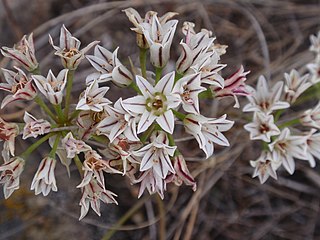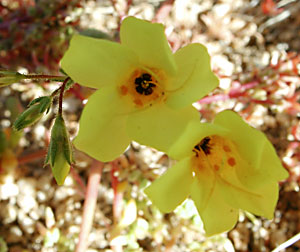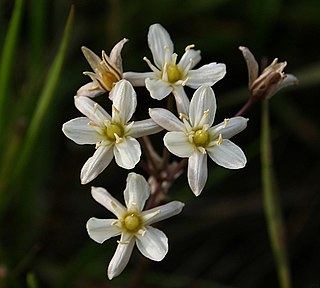
Eschscholzia glyptosperma is a species of poppy known by the common names desert gold poppy, desert golden poppy, and Mojave poppy.

Hastingsia serpentinicola is a species of flowering plant known by the common name Klamath rushlily. It is native to the mountains of northwestern California and southwestern Oregon, where it grows in serpentine soils.

Allium hickmanii is a rare species of wild onion known by the common name Hickman's onion. It is endemic to California, where it is known from Monterey, Sonoma, Kern, and San Luis Obispo Counties.

Allium lacunosum is a species of wild onion known by the common name pitted onion. It is endemic to California, where it is a common member of the flora in many types of habitat, from bayside to mountain to desert.

Anulocaulis annulatus is a species of flowering plant in the four o'clock family known by the common name valley ringstem. It is endemic to the Mojave Desert of California, especially in the vicinity of Death Valley. This is a perennial herb growing a number of thin, erect stems sometimes exceeding a meter in height from a thick caudex.
Brickellia arguta is a North American species of flowering plant in the family Asteraceae known by the common name pungent brickellbush. It is native to the Mojave and Sonoran Deserts of California, Nevada, Arizona, and Baja California.

Brickellia desertorum is a species of flowering plant in the family Asteraceae known by the common names desert brickellbush and desert brickellia. It is native to Mexico, Central America, the West Indies, and the southwestern United States.
Chenopodium fremontii is a species of flowering plant in the family Amaranthaceae known by the common name Frémont's goosefoot. Both the species' specific epithet, and the common name derive from the 19th century western pioneer John C. Frémont.

Cirsium mohavense is a species of thistle known by the common names virgin thistle and Mojave thistle. It is native to the southwestern United States, where it grows in moist areas in otherwise dry habitat, such as desert springs. It is most common in the Mojave Desert, found also in the southern Great Basin and other nearby regions of California, Nevada, western Arizona, and southwestern Utah.
Neokochia californica is a species of flowering plant in the subfamily Camphorosmoideae of the amaranth family known by the common name rusty molly. It is native to the valleys and deserts of southeastern California and adjacent parts of Nevada, where it grows in dry, alkaline soils such as alkali flats and desert washes. This is a perennial herb or small shrub growing one or more sprawling, branching stems to a maximum height near 60 centimeters. The stems are lined with narrow, elongated, somewhat flattened fleshy leaves up to about a centimeter long. The leaves and stem are coated in grayish or brownish hairs. The inflorescence is made up of one or more tiny hairy flowers sprouting from the axils of the leaves.

Leptosiphon aureus is a species of flowering plant in the phlox family known by the common name golden linanthus.

Muilla maritima is a species of flowering plant known by the common names sea muilla and common muilla. It is native to California and Baja California, where it grows in many types of habitats from the coast to the Mojave Desert and Sierra Nevada foothills and other inland mountains, in grassland, woodland, desert, and forest floras. It is a perennial plant growing from a corm and producing an erect flowering stem up to half a meter tall. The onion-like leaves at the base of the stem may be 60 centimeters long. The flowering stem bears an umbel-shaped array of many flowers on pedicels up to 5 centimeters long. Each flower has six tepals which are green-tinged white in color with brownish midribs and no more than 6 millimeters in length. At the center of the flower are six erect stamens with blue, green, or purplish anthers.

Muilla transmontana is a species of flowering plant known by the common name Inland muilla. It is native to sections of the Great Basin in Nevada and in California east of the major mountain ranges. It grows in mountain forest and scrubby high desert and plateau habitat.

Petalonyx nitidus is a species of flowering plant in the family Loasaceae known by the common name shinyleaf sandpaper plant. It is native to the deserts and desert mountains of the southwestern United States, where it grows in scrub, woodland, and other habitat. It is a clumpy subshrub made up of many rough-haired, erect or spreading stems growing 15 to 45 centimeters long. The leaves are oval, pointed, usually toothed or serrated, and up to 4 centimeters long. The inflorescence at the end of the stem is a crowded raceme of many flowers. The flower appears tubular, its white petals fused near the spreading tips but open lower, the long stamens extending well beyond the corolla, and unusual in that they emerge from outside the corolla.

Rudbeckia californica is a species of flowering plant in the family Asteraceae, known by the common name California coneflower.

Acleisanthes nevadensis is a species of flowering plant in the four o'clock family known by the common names desert moonpod and desert wing-fruit. It is native to a section of the southwestern United States encompassing southern Nevada and adjacent corners of Utah and Arizona. One occurrence has been observed in eastern California. The plant grows in desert habitat such as scrub and rocky washes. This herb produces several spreading stems up to about 30 centimeters in maximum length, sometimes from a woody base. The stems are covered in many leaves with fleshy oval or rounded blades up to 3 centimeters long which are borne on petioles. The herbage of the plant is coated in thick, wide, white, furry hairs, interspersed with shorter, flat hairs. Some hairs are glandular. Flowers occur in leaf axils. Each is a trumpet-shaped bloom with a narrow, tubular green throat up to 4 centimeters long and a round white corolla face about a centimeter wide, sometimes tinged yellow or greenish. There are five long, protruding stamens and a long style tipped with a spherical stigma. The fruit is a ribbed, hairy body with five broad, white wings.

Stanleya elata is a species of flowering plant in the family Brassicaceae known by the common name Panamint princesplume. It is native to the desert mountains of eastern California and western Nevada, where it grows in rocky and scrubby habitat types. It may also occur in Arizona. It is a perennial herb producing one or more erect stems reaching about 1.5 meters in maximum height. They are hairless and often waxy in texture. The thick, leathery leaves have lance-shaped or oblong blades with smooth or toothed edges measuring up to 15 centimeters long. They are borne on petioles. The top of the stem is occupied by a long inflorescence which is a dense, snaking raceme of many flowers. Each flower has four narrow, threadlike yellow or whitish petals each about a centimeter long and a millimeter wide. The fruit is a long, thin, wormlike silique which may be 10 centimeters in length. It contains tiny seeds.

Stylocline micropoides is a species of flowering plant in the family Asteraceae known by the common names woollyhead neststraw, woollyhead fanbract and desert neststraw. It is native to the southwestern United States and northern areas in the northern states of Mexico, where it grows in desert habitat and other dry areas. It is a small annual herb growing at ground level with stems up to 20 centimeters in length. It is woolly or felt-like in texture with a coating of white hairs. The pointed leaves are up to 2 centimeters long and alternately arranged. The inflorescence bears spherical flower heads no more than a centimeter in diameter. The head generally has no phyllaries, or has small ones that fall away early. It contains several woolly white flowers.

Xylorhiza orcuttii is a perennial plant in the family Asteraceae known by the common name Orcutt's aster. It is native to southern California and northern Baja California, where it grows in scrubby habitat in the dry canyons of the Sonoran Desert. It often grows in rocky and sandy substrates, clay, and alkaline soils amongst cactus. It is a shrub with branching, mostly hairless stems that may reach 1.5 meters in length. The leaves are lance-shaped to oblong with smooth, toothed, or spiny edges. The inflorescence is a solitary flower head with up to 40 or more lavender or pale blue ray florets, each of which may measure over 3 centimeters in length. Flowering may begin as early as late fall or winter. The fruit is an achene which may be over a centimeter long, including its pappus of bristles.

Toxicoscordion paniculatum is a species of flowering plant known by the common names foothill deathcamas, panicled death-camas, and sand-corn. It is widely distributed across much of the western United States, especially in the mountains and deserts of the Great Basin region west of the Rocky Mountains. It grows in many types of habitat, including sagebrush plateau, grasslands, forests, and woodlands, etc.

















